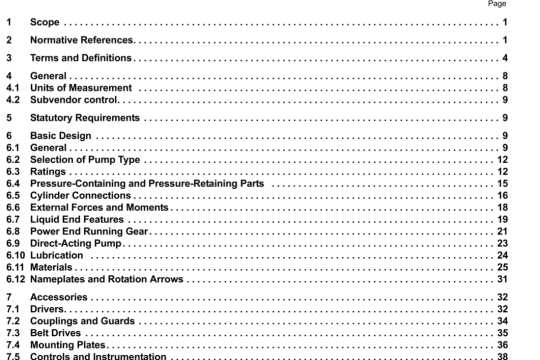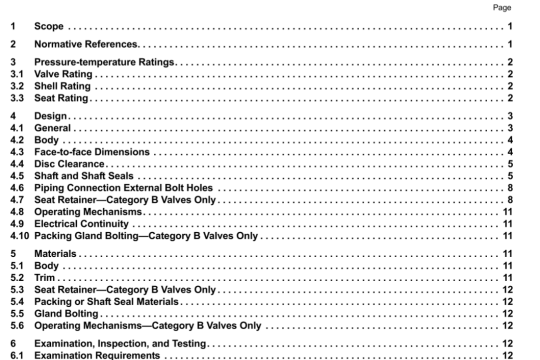API RP 615:2010 pdf download
API RP 615:2010 pdf download.Valve Selection Guide.
NPS 2 in Class 800 with threaded or socket-welding ends. The standard port size Is smaller than the line size but full port is an available option. These small valves are usually made from forgings. Flanged-end and butt-weld end valves are available where use of socket weld or threaded ends may not be desired, for example, in compressor lube oil service. See Figures A.2 and A.3 for typical examples of API 602 gate valves,
5.1.1.4 API 603 Gate Valves
API 603 was developed to provide a lower cost alternative to API 600 valves in corro&ve. lower pressure services. They provide a lighter-weight, corrosion-resistant design made 01 a stainless or nickel alloy with a thinner body wall than API 600 valves. API 603 specifies wall thicknesses comparable to those in ASME B16.34. Like API 600, API 603 specifies minimum stem diameters. These valves are available in flanged or butt-weld ends in pressure classes 150, 300. and 600 and in sizes NPS 112 through NPS 24. The wedge design is typically solid or flexible although split wedge and parallel-sided double disc gates are covered in the standard. Hardfacing may be specdied to reduce galling tendency of stainless wedge seat faces to stainless body seat faces. See Figure A.4 for an example of a gate valve from API 603.
5.1.1.5 Pressure seal Bonnet Gate Valves
Gate valves with a special “pressure sear bonnet closure design that avoids bonnet flanges are available from several manufacturers for Class 600 and higher and may typically be used in hydrogen service. The pressure seal bonnet design uses a compact body-bonnet joint that is pressure-assisted so that with increasing pressure the bonnet seals more tightly. The use of this design should be restricted to services that are not highly corrosive to avoid damage to the pressure seal element. Maintenance that involves reassembly of the pressure seal should be done with the help of a manufacturer’s representative or a qualified valve repair organization to ensure proper assembly, testing, and preloading of the seal ring. Replacement seal rings may be available only from the original manufacturer. These valves are often supplied with weld ends thereby eliminating heavy line flanges. This valve design is not covered wi API 600.
5.1.1.6 Orientation Considerations
While somewhat dependent on pressure class, gate valves larger than about NPS 8 oriented in any position other than with the stem vertical may result with the disc getting hung up against the inside body guides such that the valve may get stuck and not be operable. Special attention to guiding details including dearances, avoidance of sharp corners on the disc leading edge, and the possible use of machininglhardfacing on the guides is recommended. Even with the stem vertical there may be an accumulation of dirt and other deposits between the seats such that the valve may not close fully. Installation of a bleed valve between the body seats to provide a purge connection may be considered to address this potential build-up.
5.1.1.7 Other Gate Valve DesIgns
Other gate valve designs used in process plants that are less common include double disc designs. knhfe gate” designs sometimes used in water service and special design “slide valves” used in high temperature, highly erosive fluid solids service such as in fluid coker units.
The body rating Is determined from ASME Standards B16.34 (standard dass), B16.42 for ductile Iron, or B16.24 for cast copper alloys dependrng on the body material. Category B butterfly valves are specified in sizes up to NPS 48 for double flanged designs and up to NPS 24 for lug and wafer designs. The lug type or “single flanged” has bolting lugs provided threaded as standard but optionally may be ordered dnlled through. Category B valves are known as “high performance” butterfly valves. See Figure All for a typical category B Butterfly Valve.
51.4.4 Triple Offset Designs
In addition to the double offset disc designs, there is also the triple offset design, which uses an angled-seat geometry to allow shaft dosing torque to compress the sealing element more tightty to provide for a better seal. Since the body seat has a complex geometry. repair or replacement of a damaged seat may require special equipment See Figure A.12 for an example of a tnple offset design
5.1.4.5 OrIentation ConsIderations
Although butterfly valves are operable in any orientation, the preferred orientation for butterfly valves is with the stem horizontal to avoid debris collection and bearing wear that may occur with the stem vertical.
5.1.5 Globe Valves
Although mainly considered for throttling service, globe valves are another valve type that may be used as a block valve. These will be discussed in more detail in 5.3.




